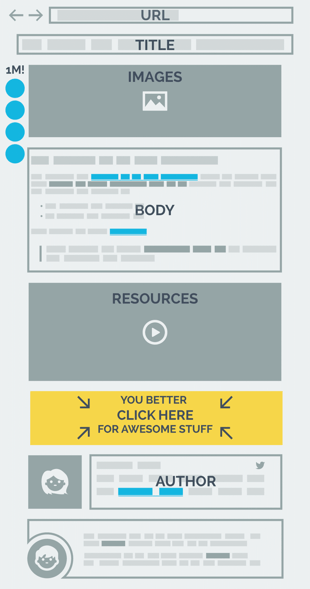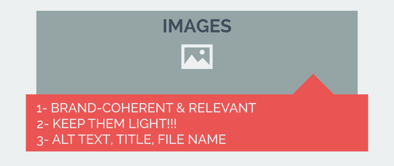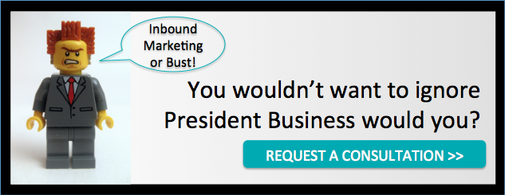
You can focus on so many things. But, a blog post always has a goal. Usually, getting a lead or making you or your company more known. To get traffic and conversions, you’ll need to start blogging to be seen – and that’s exactly what this blog is about. To put it simply, this is a hardcore anatomy class on blog posts.
Sound boring? Don’t worry, this post comes with drawings!

The Anatomy of a Blog Post that Converts
For a high converting blog post that drives lots of traffic, you’ll need:
- A great title and URL.
- A description that serves as a click magnet.
- Optimised and mesmerising images.
- Engaging text.
- Resources to break up the text and add variety.
- A captivating CTA.
- Ways to easily share it and engage with it
- An author
This will grant you two things: traffic and guiding that traffic down your conversion funnel.
Optimizing your Post’s Title
Here are 6 blogging truisms to bear in mind when approaching your title:
- It’s the most important part of your blog post
- Crucial for Click through rate and SEO
- Keywords are (still) important
- The first and last 3 words are the most important
- A good title solves a problem
- For best results, keep it below 55 characters
According to Copyblogger’s 80/20 rule, 8 out of 10 people will read your title and only 2 out of 10 will read your post. Not only that, but the title (H1) is an important ranking factor for any content, even if it’s lost some traction over the years.
Therefore, the title is the single most important part of your blog post: give it time and thought.
The objective here is to create a no-so-vicious vicious cycle. The higher your title gets your post ranked, the more clicks it will get. If you could complement that algorithmic process with some human persuasion, making your title seem more helpful, fun or trustworthy, you’ll gain even more clicks and an even better ranking, starting the cycle anew. This is the circle of CTR (click-through rate.)

That doesn’t mean keywords are unimportant: If you’re going to write about a topic, it should naturally appear in the content and in the title. Be sure you choose the correct terminology, the things people are searching for and the words they’re using. But it’s 2015: don’t waste your time with any active attempt to artificially introduce keywords in your post.
Of course, make sure that the keyword is either part of the first or the last three words of the title. Smarter people than I have established that the those are the most important words in a headline.
Keep in mind that your title tag has to be below the 55 characters mark or it won’t show completely in the in Google results. Often your blog will add the brand at the end so count that too. Use MOZ’s title tool to check how it will appear in Google.
These tips should be used as a guideline. They’re the basis for building a blog post, but they shouldn’t limit your creativity, they should make your ideas sharper, more accessible, and successful. Feel free to break them if you come up with something better, but make sure you know them and, if you don’t use them, that it is for a good reason.
Optimizing Your Post’s URL
You can read Rand Fishkin’s guide to URLs and skip this section. If you’ll feeling lazy though, let me break it down for you.

- Add the keyword
- Less is better than more
- Remove stop words…
- …but be clear
The URL is that thing that you don’t even think about, it’s almost unimportant to the user (emphasis on almost), but has an important role in SEO.
Having the keyword in the URL is not only good for SEO, but also good for CTR. The keyword in the URL is highlighted in the search results, and if you’re sharing it through SMS or email, seeing the topic in a clear, orderly way makes you trust the source.
To make the URL as easy to understand as possible, make sure you keep it as short as you can while making sense. In order to do so, avoid including words that don’t add meaning to the content. We call these stop words (and, to, or, of the, etc.) and you should delete them from the URL.
Warning: Do not be a robot. Retain commonsense. Sometimes you can’t get rid of everything, or leaving stop words increases the clarity (and even the SEO value) of the post. For example, if you’re writing “How to” posts, having the “to” in the URL may add value.
Choosing and Optimizing Your Post’s Images
 Whether a user clicks on your link or not will depend, more than anything, on the visual assets you use with it. Especially, the featured image. It’ll be the one appearing in social media when someone shares your post.
Whether a user clicks on your link or not will depend, more than anything, on the visual assets you use with it. Especially, the featured image. It’ll be the one appearing in social media when someone shares your post.
- Make them relevant to and coherent with your branding
- Make sure it’s as light as possible
- Check the alt tags, the image title, and file name
Ideally, images will be a part of your blog’s identity. If you’re using high quality, colourful images, make sure you use them in all your posts. If you’re using vector images, always use them. Minimalistic, vector images are a trend right now. If you use colour well, you can create featured images that weigh as little as 2 or 3 Kb.
Because load times are important -now more than ever- and using light, powerful images can be what sets you apart in terms of performance. Be sure you are using software to remove metadata from images, that you’re optimising them and you know when to use a png, a jpeg or a gif.
There is a great tool called Canva Presentation which can blow your audience away with a their collection of high-quality templates. Free to personalize and completely online, the Canva tool can easily be modified and used to collaborate with your workmates, teammates and colleagues.
Last but not least, pay attention to the image title, description, and file name. The description is, not only useful to search engines, but also for people with visual disabilities, since special software reads the alt title, so the user may interpret what’s in them. The title and the file name may not be as relevant, but I’d recommend using proper, relevant names. It isn’t difficult to do and won’t do any harm. It could help, if not now, then perhaps in future algorithm changes.
This is the first in a series of guest posts on SEO from Bruno Rodriguez Armesto, Head of Inbound Marketing at ThunderMetric.

by The Penguin Team on July 22, 2015
As a leading B2B digital marketing agency, We help B2B Technology Companies, enterprise software, and hardware companies increase brand awareness, reach more qualified leads and close more customers. Penguin Strategies is a Diamond Partner of HubSpot.






